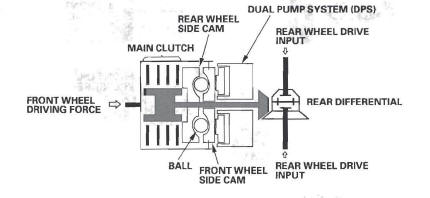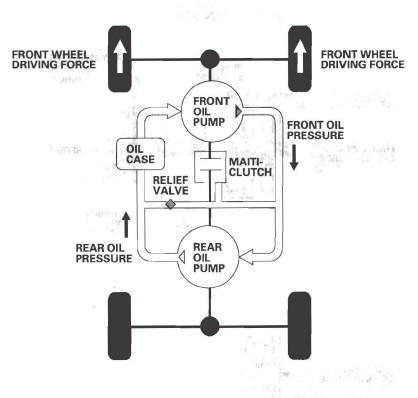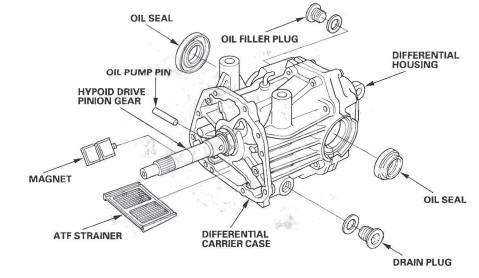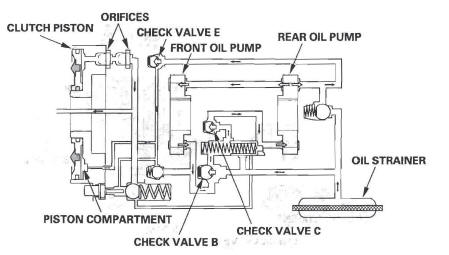Honda CR-V: System Description
Outline
The rear differential has a real-time 4WD control mechanism that enables 4WD by transmitting appropriate driving force from the front wheels to the rear wheels when necessary. It uses a real-time 4WD dual pump system (DPS) with a light and compact cam mechanism, and integrates the drive control system to the rear differential.
Equipped with a cam mechanism, this DPS real-time 4WD detects the speed difference between the front and rear wheels. When speed difference is small, the one-way cam works to minimize the time lag for the pump to produce hydraulic pressure.
When the speed difference is large, hydraulic pressure develops in the two pumps. By controlling the engagemment of the main clutch, the driving force transmitted to the rear wheels is optimized according to the driving conditions. By using a limiter switch to prevent transmission of excessive torque to the rear wheels, the propeller shaft and differential unit can be lightweight and compact. For the differential fluid, DPSF (dual pump system fluid) is exclusively used.


One-way Cam Operation
The one-way cam unit consists of two cams (front wheel and rear wheel) that sandwich balls, and it detects by the speed difference in the front and rear wheels.
When a difference of the front and rear wheel speeds develops, a difference in the rotational speed of the two cams also develops, and the front cam rotational speed exceeds that of the rear cam. When this happens, the balls move along the cam groove, pushes and widens the cams, and applies pressure to the main clutch. When the speed difference becomes greater, the dual pump system (DPS) operates. Since the cam unit is a one-way type, it only operates when driving forward.
NORMAL DRIVING:

CAM UNIT OPERATION:

DUAL PUMP SYSTEM (DPS) OPERATION:

Dual Pump System (DPS) Operation
For non-slippery roads (no slipping): DPS not operating
When the front and rear wheel speeds are equal (no slipping) as in normal driving, the oil discharged in the front wheel and oil drawn in the rear pump are equal, so a hydraulic pressure that pushes the wet-type multi-clutch is not developed, and the rear wheels are not driven.

For slippery roads (with slipping): DPS operating
When the front wheel speed is more than the rear wheel speed such as in starting, acceleration, and driving on a slippery road surface, the amount of oil discharged by the front pump exceeds the oil drawn by the rear pump, thus producing hydraulic pressure that presses the wet-type multi-plate clutch, and transmits driving force to the rear wheels.
When the speed of the front wheels becomes even greater than the rear wheels, the torque limiter mechanism (relief valve) limits the hydraulic pressure that pushes the wet-type multi-plate clutch, and transmits only the necessary driving force to the rear wheels as needed by 4WD driving.

Construction of the Rear Differential
The rear differential assembly consists of the torque control differential (TCD) that controls the 4WD mechanism and the rear differential mechanism section.

TCD
The TCD consists of the TCD case, differential assembly, clutch, one-way cam, and the oil pump body assembly.

Differential clutch assembly
The differential clutch assembly is composed of the clutch guide, clutch disc A/B, clutch hub, pressure plate, and also the one-way cam, pilot clutch assembly, and other parts. The clutch guide gets the front wheel driving force from the propeller shaft, while the clutch hub meshes with the hypoid drive pinion-gear, and follows the speed of the rear wheels.

Construction of the one-way cam
The one-way cam consists of the base cam that spins with the clutch guide via the pilot clutch, the apply cam that meshes with the clutch hub, and a steel ball that is sandwiched by the two cams. The base cam rotates at front wheel speed and the apply cam rotates at rear wheel speed.
When speed difference develops, the steel ball moves along the groove in the base cam, and according to the shape of the groove, pushes the apply cam outwards.

Pump body assembly
The pump body assembly consists of the front oil pump, rear oil pump, and rear oil pump cover, and it has a built-in hydraulic circuit. The front oil pump is driven by the pressure plate component.
The rear oil pump is driven by the hypoid drive pinion gear.
The front and rear adopts trochoidal pumps. Moreover, the rear oil pump capacity is set 2.5% higher than the front oil pump capacity, and is designed for the speed difference caused by wear in the front tires, as well as for tight corner braking.

Differential carrier
This is composed of the hypoid drive pinion gear, hypoid ring gear, differential, and other parts.

Power Transmission
During 2WD driving: DPS (dual pump system) not in operation
The front wheel driving force from the propeller shaft is transmitted to the clutch guide and the clutch plate.
When DPS is not operating, the rear wheels follow the front wheels. From the rear driveshafts, the rear wheel operation is input to the differential, link gear, drive pinion gear, clutch hub, clutch disc, and power is not transmitted to the rear wheels.
During 4WD driving: DPS operation
The front wheel driving force from the propeller shaft is transmitted to the clutch guide and the clutch plate.
When the one-way cam operates, the clutch plate and clutch disc become connected, and from the clutch hub, the driving force is transmitted to the pinion gear, ring gear, differential, rear driveshafts, and to the rear wheels.

Hydraulic Circuit
Construction of the hydraulic circuit
Built inside the oil pump assembly, the hydraulic circuit provides clutch assembly lubrication together with 4WD control. The hydraulic circuit consists of the front and rear oil pumps, the front valve and five check valves for hydraulic route switching, the choke section which is the hydraulic path to the clutch piston compartment, and the two orifices that controls the hydraulic pressure in the piston compartment.
It is equipped with a system protection function with a wax-pellet-style thermal switch and relief valve.


Operation of the hydraulic pressure circuit
1. Forward starting and acceleration (4WD)
- When the front wheel speed exceeds that of the rear wheel speed during forward starting and acceleration, and driving on slippery roads, the front oil pump speed exceeds that of the rear oil pump, producing hydraulic pressure.
- The oil drawn in by the front oil pump from the oil strainer, passes through check valve B, and is drawn in or discharged.
- Oil discharged from the front oil pump is drawn in by the rear oil pump. However, when the drawing capacity of the rear oil pump is exceeded, the excess oil passes check valve E, is pumped to the piston compartment, pushes the clutch piston to connect it to the clutch assembly, and transmits driving force to the rear wheels.
- Oil in the piston compartment is adjusted by the two orifices. Oil that passes through the orifices lubricates and cools the clutch assembly interior and the hypoid pinion gear shaft.

2. Forward driving at constant speed (2WD)
- When driving forward at a constant velocity, the speeds of the front and rear wheels are equal, thus there is no speed difference between the front and rear oil pumps.
- Oil discharged from the front oil pump is drawn in by the rear oil pump, and the oil discharged from the rear oil pump is again drawn in by the front oil pump. The oil circulates only between these two oil pumps. Since hydraulic pressure does not develop in the piston compartment, the clutch assembly is not connected, and rear wheel drive is not engaged.

3. Forward deceleration (2WD)
- During forward deceleration, the rear wheel speeds exceeds the front wheel speed because of braking characteristics, and the rear oil pump speed exceeds the front oil pump speed.
- The oil drawn in by the rear oil pump from the oil strainer, passes through check valve A, and is drawn in or discharged.
- Oil discharged from the rear oil pump is again drawn in by the rear oil pump, and is circulated. Thus, the piston compartment does not produce hydraulic pressure, so that the clutch assembly is not connected, and rear wheel drive is not engaged.

4. Reverse starting and deceleration (4WD)
- When the front wheel speed exceeds that of the rear wheel speed during reverse starting and acceleration, and driving on slippery roads, the front oil pump speed exceeds that of the rear oil pump, thus producing hydraulic pressure.
- During reverse driving, the oil pumps rotate in reverse. However, the oil drawn in by the front pump from the oil strainer passes the check valve A and rear oil pump, and then is drawn in and discharged by the front oil pump.
- Oil discharged by the front oil pump but exceeding the drawing capacity of the rear oil pump passes through check valve F, travels to the piston compartment and is pressure-regulated in the two orifices.
- Hydraulic pressure pushes the clutch piston to connect it with the clutch assembly interior, and via the propeller shaft, transmits driving force from the transmission to the rear wheels.

5. Reverse driving at constant speed (2WD)
- When reverse driving at constant velocity, the front and rear wheel speeds are equal, so that no speed difference exists between the front and rear oil pumps.
- When reverse driving, the oil pumps rotate in reverse. However, the oil discharged from the front oil pump is drawn in by the rear oil pump. Likewise, the oil discharged by the rear oil pump is again drawn in by the front oil pump and is circulated.
- The excess oil coming from the difference in capacity of the front and rear oil pumps, although in small amounts, passes through check valve E and goes to the piston compartment. However, the hydraulic pressure is low so that the clutch piston is not moved, and rear wheel drive is not engaged.

6. Reverse deceleration (4WD)
- During reverse deceleration, the rear wheel speed exceeds the front wheel speed because of braking characteristics, thus the rear oil pump speed exceeds the front oil pump speed.
- During reverse driving, the oil pump rotates in reverse, but the rear
oil pump draws in oil from the oil strainer.
The oil pump passes through check valves B and C, and is drawn in by the rear oil pump.
- Excess oil from the oil discharged from the rear oil pump exceeds the drawing capacity in the front oil pump, passes through the check valve E, travels to the piston compartment, and is pressure-regulated at the two orifices.
- Hydraulic pressure presses the clutch piston to connect with the clutch assembly interior, and transmits driving force from the transmission to the rear wheels via the propeller shaft.

Emergency hydraulic pressure circuit operation
7. Thermal switch operation
- During 4WD driving, adjusted oil acts on the relief valve and the clutch piston.
- When the differential oil becomes abnormally hot, the thermal switch pushes the check valve, and the hydraulic pressure in the clutch piston is released, so that 4WD is disabled to protect the system.

8. When the relief valve is in operation
- During 4WD, adjusted oil acts on the relief valve and the clutch piston.
- When hydraulic pressure exceeds the spring tension at the release spring, the check valve opens, the oil pressure in clutch piston is maintained, and excessive torque input to the rear wheel drive system is prevented.


